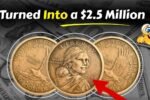Join on WhatsApp
Get the latest updates directly on WhatsApp – motivation, news & more!
Rare 1776–1976 Quarter: In 1976, America celebrated 200 years of independence, and the U.S. Mint released a special quarter to mark the occasion. Known as the Bicentennial Quarter, it features a colonial drummer on the reverse and the dual dates “1776–1976.” While billions were minted, making it one of the most common coins in circulation, legends of ultra-rare versions have captured the imagination of collectors worldwide. Some stories even claim the existence of a single coin worth billions though this figure is widely considered more myth than fact.
The Background of the Coin
To honor the nation’s bicentennial, over 1.6 billion quarters were produced, replacing the usual eagle design with the drummer boy. These coins were struck in copper-nickel and released for general circulation, ensuring they quickly became a familiar piece of pocket change. Despite this, a few intriguing anomalies have surfaced over the years, including coins with unusual metals or minting mistakes.
Collectors whisper about coins made from gold-platinum alloys or examples with “double-die” errors, where letters or numbers appear slightly doubled. While there’s no verified record of a $2.5 billion quarter, stories of these rare pieces continue to excite coin enthusiasts and casual collectors alike.
Why Some Quarters Could Be Valuable
In the coin world, rarity drives value. While most Bicentennial Quarters are worth their face value, certain factors can make a coin much more valuable:
- Unusual Metal Composition: Coins accidentally struck on gold or platinum could be nearly priceless due to their scarcity.
- Double-Die Strikes: Doubling on inscriptions like “LIBERTY” or the date can make a coin highly collectible.
- Minting Errors: Off-center strikes, missing layers, or unique finishes often attract collectors.
Even though the notion of a billion-dollar quarter is highly speculative, rare coins have sold for tens of thousands or even millions before.
Could You Find One in Your Pocket?
While unlikely, the possibility exists that a rare Bicentennial Quarter could appear in everyday change. Coins have been discovered in old collections, jars, and even in cash registers, so careful observation can sometimes pay off.
How to Identify a Potentially Valuable Quarter
If you want to check your coins, here are a few tips:
- Color: Look for an unusual golden or shiny appearance.
- Weight: Standard quarters weigh 5.67 grams; heavier coins could indicate a different metal.
- Magnet Test: Gold-platinum coins won’t respond to a magnet.
- Examine the Design: Check for doubled letters or numbers on the front.
- Professional Grading: Only certified graders from PCGS or NGC can confirm authenticity.
Other Collectible Bicentennial Quarters
Even if you don’t find the legendary coin, several Bicentennial Quarters remain valuable:
- 1976-S Silver Proof: Struck in 90% silver and highly sought after.
- Double Die Obverse: Coins with noticeable doubling on the obverse design.
- Clad Error Coins: Resulting from misaligned metal layers during production.
The Hunt for Hidden Treasures
Whether or not the fabled $2.5 billion quarter exists, it has inspired countless people to examine their change more closely. While most coins will remain worth 25 cents, the thrill of possibly uncovering a rare or valuable piece keeps collectors searching and sometimes discovering unexpected treasures.
So next time you reach for a quarter, take a closer look. You might be holding more than just pocket change you could be holding history.


